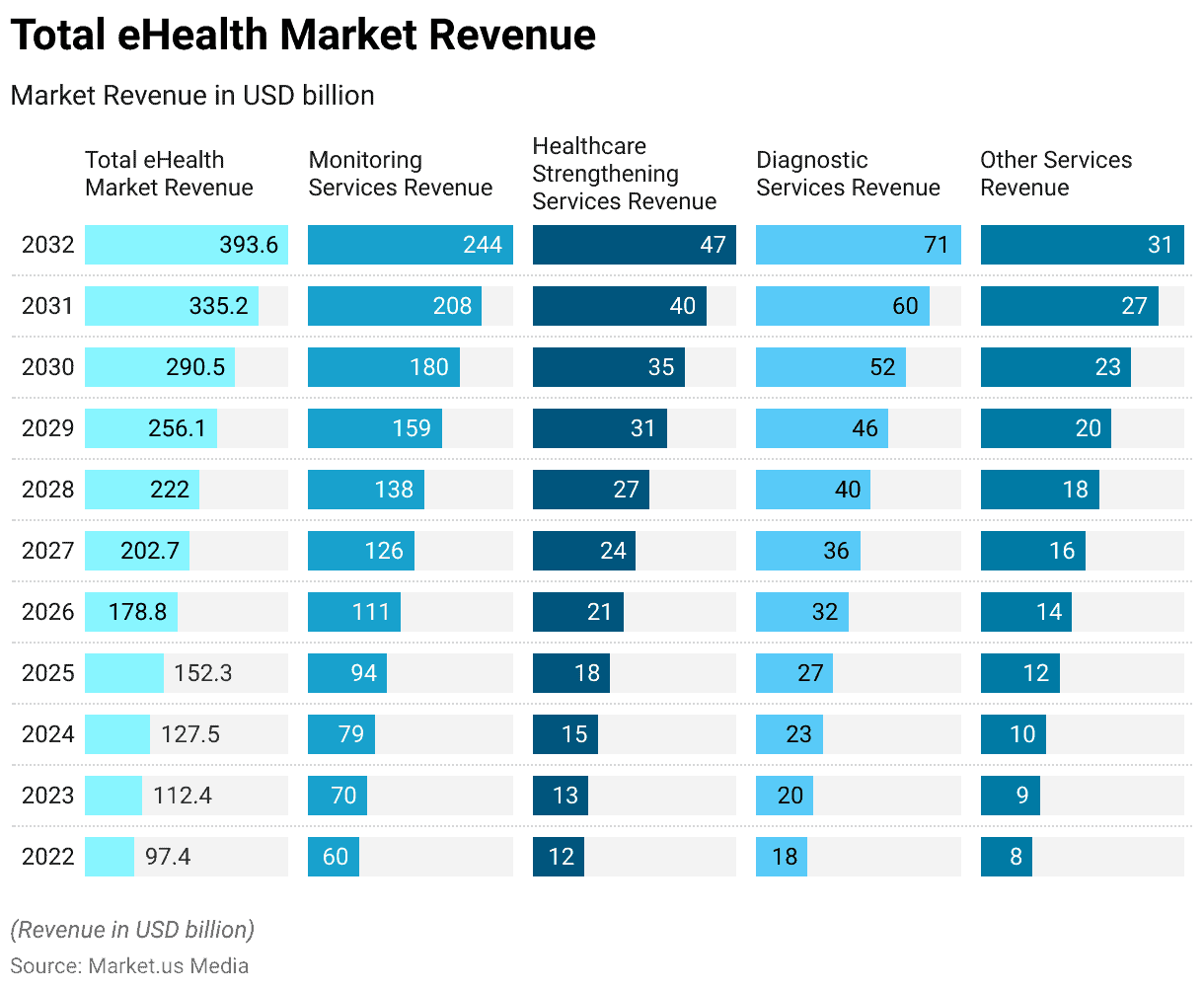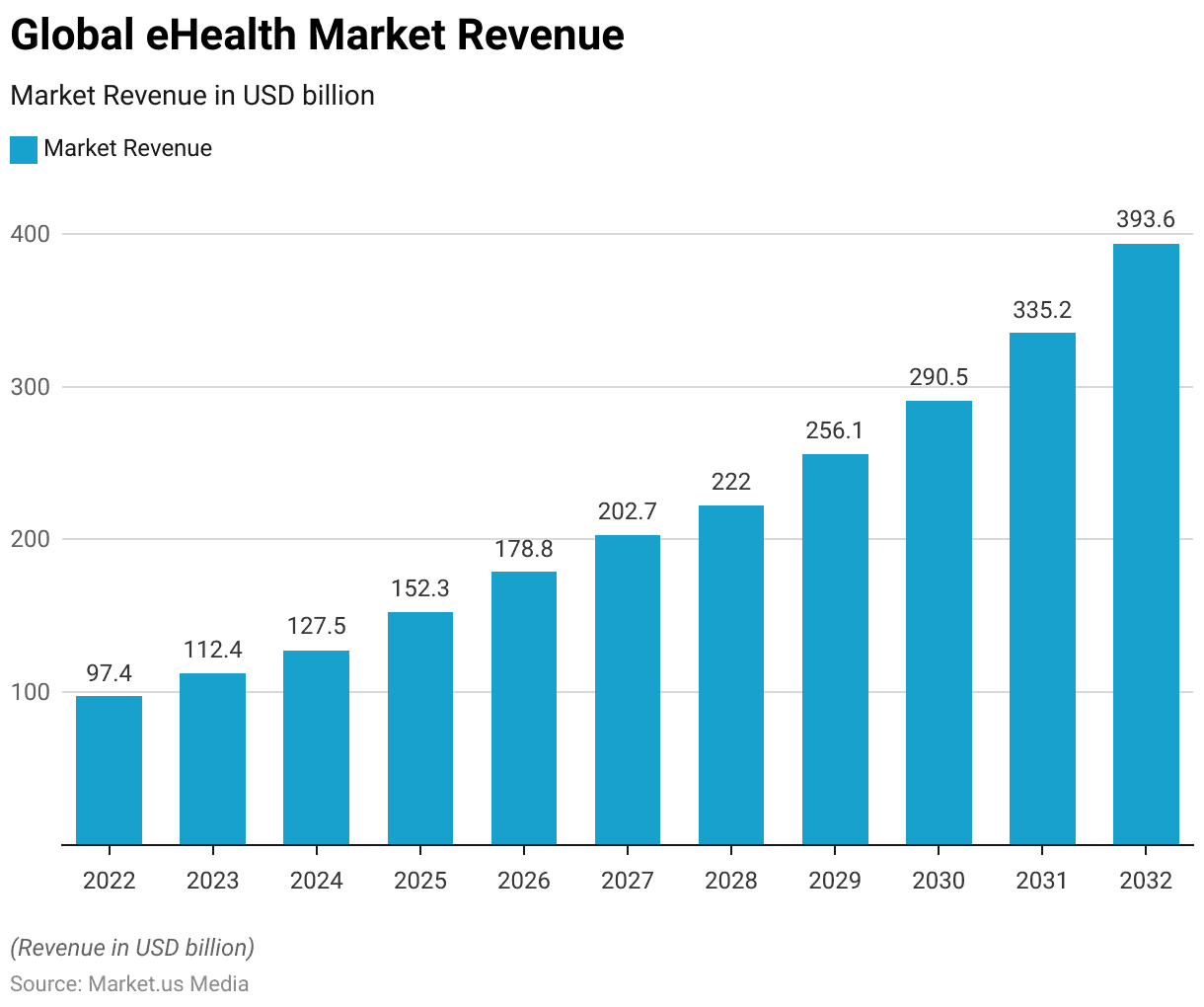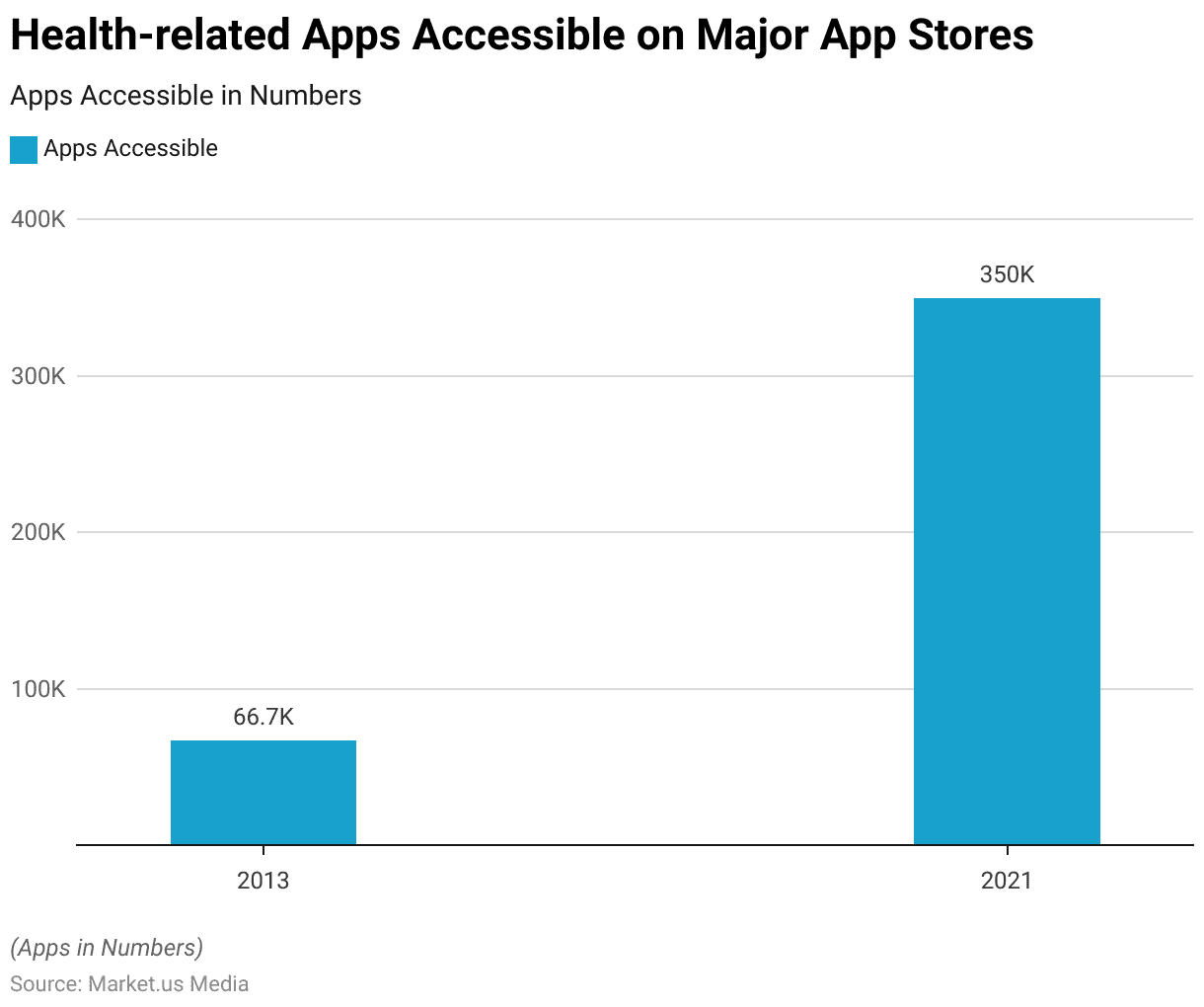Table of Contents
Introduction
According to eHealth Statistics, eHealth, or electronic health, is the fusion of healthcare and technology. It employs digital instruments such as electronic health records, telemedicine, mobile applications, wearable devices, and health information systems to elevate patient care and healthcare operations.
eHealth offers advantages like enhanced care, reduced expenses, greater accessibility, and increased patient involvement.
However, it also introduces difficulties like safeguarding data and ensuring systems work together smoothly. In sum, it’s revolutionizing healthcare by utilizing technology to improve patient results.
Editor’s Choice
- The global eHealth market is experiencing substantial growth at a CAGR of 15.4%
- In 2022, the market’s revenue stood at USD 97.4 billion, and this figure is anticipated to increase to USD 393.6 billion in 2032.
- In 2022, the total eHealth market revenue reached USD 97.4 billion. Monitoring services accounted for the largest share with USD 60 billion, followed by healthcare strengthening services at USD 12 billion, diagnostic services at USD 18 billion, and other services at USD 8 billion.
- Approximately 60% of EHR users express contentment with the system, while only 28% have voiced dissatisfaction.
- Ninety-three percent of healthcare professionals find telehealth to be an acceptable means of delivering patient care, with 60% expressing “very satisfied” experiences.
- In 2021, the total number of wearable devices shipped reached 533.6 million, encompassing various categories like hearables, watches, wristbands, and other wearables.
- In 2021, investors poured nearly $45 billion into the digital health sector, marking a significant doubling of the previous year’s investment and the highest amount since 2010.

Global eHealth Market Overview
Global eHealth Market Size
- The global eHealth market is experiencing substantial growth at a CAGR of 15.4%, with revenues projected to follow an upward trajectory over the next decade.
- In 2022, the market’s revenue stood at USD 97.4 billion, and this figure is anticipated to increase to USD 112.4 billion in 2023.
- Looking further ahead, the market is projected to achieve remarkable growth, with anticipated revenues of USD 335.2 billion in 2031 and USD 393.6 billion in 2032.

eHealth Market Size – By Service
- The global eHealth market is poised for substantial growth in the coming years, as indicated by the projected revenue figures.
- In 2022, the total eHealth market revenue reached USD 97.4 billion. Monitoring services accounted for the largest share with USD 60 billion, followed by healthcare strengthening services at USD 12 billion, diagnostic services at USD 18 billion, and other services at USD 8 billion.
- This growth trend is expected to continue throughout the forecast period, with the market reaching a substantial USD 393.6 billion by 2032.
- Monitoring services are projected to maintain their lead, with USD 244 billion in revenue, followed by diagnostic services at USD 71 billion, healthcare strengthening services at USD 47 billion, and other services at USD 31 billion.

Global eHealth Market Size – By End-user
- The global eHealth market is characterized by a diverse range of end-users, each playing a crucial role in shaping the landscape of digital healthcare.
- Among these, healthcare providers occupy the largest share, commanding a significant 53% of the market.
- This includes hospitals, clinics, and healthcare facilities that leverage eHealth solutions to enhance patient care, streamline operations, and improve overall healthcare delivery.
- Healthcare payers, with a substantial 22% market share, represent insurance companies and organizations responsible for covering healthcare costs.
- They are increasingly embracing eHealth technologies to optimize claims processing, monitor patient outcomes, and manage costs more effectively.
- Healthcare consumers, comprising 18% of the market share, are a vital demographic driving the demand for eHealth solutions.
- Individuals are becoming more proactive in managing their health, utilizing mobile health apps, wearable devices, and telemedicine services to monitor their well-being and access medical advice conveniently.

eHealth Infrastructure
Electronic Health Records (EHRs)
- A recent survey by the ONC reveals that nearly all hospitals nationwide have integrated certified Electronic Health Records (EHRs) into their operations.
- Approximately 60% of EHR users express contentment with the system, while only 28% have voiced dissatisfaction.
- More than 83% of healthcare professionals find EHRs to be beneficial in managing tasks like patient records, prescription orders, clinical notes, medications, problem lists, and accessing lab results.
- In terms of EHR adoption rates in the United States, there has been a significant uptick, rising from 40% in 2012 to 67% in 2017.
- Furthermore, almost 95% of hospitals eligible for the Medicare and Medicaid EHR Incentive Program have successfully met the criteria for meaningful use of certified health IT.
- According to reports, primary care doctors lead in the adoption of certified Electronic Health Records (EHRs) with a rate of 79%.
- In community healthcare centers, medical practitioners have an impressive EHR adoption rate of 98%, with approximately three-quarters using certified EHRs.
Telemedicine
- Around 80% of individuals have experienced telemedicine services at least once.
- Approximately 76% of people aged 55 and older have utilized telemedicine. In rural areas, telemedicine is used by about 73% of the population.
- Remarkably, 98% of transgender patients have reported using telemedicine.
- Patients opt for telemedicine primarily to handle prescription needs, with a preference rate of 61%.
- In the upcoming five years, consumers anticipate an increased utilization of virtual healthcare offerings.
- Ninety-three percent of healthcare professionals find telehealth to be an acceptable means of delivering patient care, with 60% expressing “very satisfied” experiences.
Mobile Health (mHealth) Apps
- mHealth applications have become highly prevalent in the healthcare sector, covering a wide range of medical conditions and usage scenarios.
- According to a report from the IQVIA Institute in July 2021, there are over 350,000 health-related apps accessible on major app stores worldwide, with over 90,000 new additions in 2020.
- This reflects substantial growth since 2013 when there were merely 66,713 healthcare apps available to consumers.
- While around 54% of the apps in 2020 were related to fitness, lifestyle, and dietary matters, the rest were dedicated to managing specific health conditions. This shift indicates a growing demand for clinically-oriented apps as virtual healthcare continues to expand.
- In 2020, telehealth stood out as the top investment sector in mHealth, drawing in around $1.78 billion in funding.

Wearable Health Devices
- In 2021, the total number of wearable devices shipped reached 533.6 million, encompassing various categories like hearables, watches, wristbands, and other wearables.
- Projections indicate that the global smartwatch shipments are expected to exceed 253 million units by 2025.
- In 2020, Fitbit had 31 million active users who engaged with their device at least once a week.
- As per information from a Guardian article in January 2020, there were approximately 18 million users of Garmin watches at that time.
- According to a study conducted by the Journal of Internet Medical Research, 30% of the American population utilizes wearable health devices.
- Deloitte Global’s forecast suggests that in 2022, around 320 million wearable devices focused on consumer health and wellness will be shipped globally.
eHealth Investment Statistics
- In 2021, investors poured nearly $45 billion into the digital health sector, marking a significant doubling of the previous year’s investment and the highest amount since 2010.
- However, in 2022, funding decreased to $23.3 billion, though it remained the second-highest annual funding level within the given time frame.
- In 2015, all the funding allocated for eHealth programs in the 28 European Union countries was sourced from public funding.
- India hosts approximately 5,295 health-tech startups, with 133 of them being funded eHealth startups.
- The projected growth of the eHealth market in the country is estimated to reach $10.6 billion by 2025.
Discuss your needs with our analyst
Please share your requirements with more details so our analyst can check if they can solve your problem(s)



